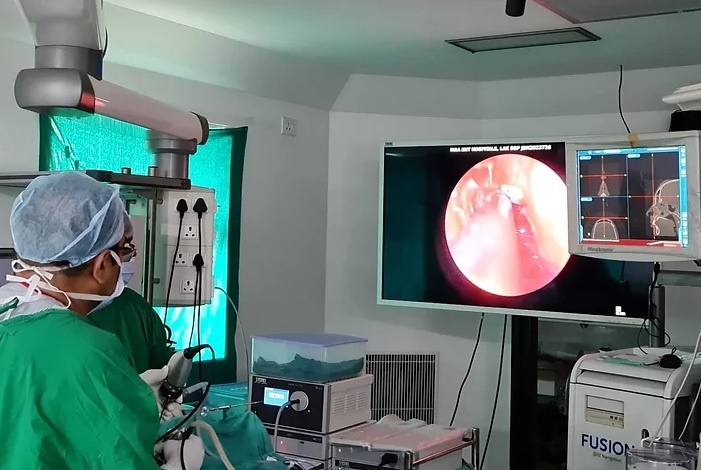Suppose you or a loved one is suffering from sinusitis. In that case, sinus surgery can improve health and quality of life if antibiotics are not working.
This guide will provide information on the types of surgery for sinusitis available, including traditional surgery, FESS procedures, and the latest techniques.
Although we didn’t mention any costs here, you can decide what technologies to choose according to your available options and budget.
If you want to read about the treatment for sinusitis and when a doctor suggests surgery. Please refer to our "Treatment for Sinusitis- Acute, Chronic & Subacute stages."
Sinusitis Surgery, Open sinus surgery, Functional Endoscopic Sinus Surgery, TFSE Sinus surgery, Total Fronto Spheno Ethmoidectomy surgery, Debriders in sinus surgery, endoscopic balloon sinuplasty, EBS
NOTE: It's important to know that surgery for fulminant fungal sinusitis (such as mucormycosis) differs from surgery for other types of sinusitis.
Traditional Open Sinus Surgery
Traditionally, open sinus surgery involves cutting into the skin to access the sinuses. The mucosa (the sinus lining) is also removed along with the disease. This surgery often resulted in facial scars and disfigurement. The surgery had a 90% failure rate within 2-3 years. We, doctors, did not always address the underlying causes of sinusitis. The recurrence of the disease after surgery was very common.
Functional Endoscopic Sinus Surgery (FESS) or Messerklinger Technique
The use of endoscopes in sinus surgery began in the mid-1980s. Using endoscopes gave us a deeper understanding of sinus physiology and its functions.
These findings have helped Stammberger develop the Functional Endoscopic Sinus Surgery technique. Functional Endoscopic Sinus Surgery, in short, is called FESS. As the surgery was based on concepts proposed by Messerklinger, FESS was even called the Messerklinger technique. Messerklinger emphasized preserving the mucosa and clearing blockages in the osteomeatal complex area, which was followed in FESS.
Although this technique was developed around 1985, in India, we started using it in the early 1990s. This was the time I was pursuing my master's. So all the department staff members learned about this surgery simultaneously.
We were initially happy that FESS avoided scarring and disfigurement. But 70% of patients were reinfected with a sinus infection within 3 to 4 years. So, the success rate was 30%, on the bright side, three times more than the previous method.
Why did Messerklinger’s Technique or FESS Fail?
There are around 40 sinuses in our body. But as Messerklinger says that only 4 or 5 sinuses in the osteomeatal complex area or OMC need an operation. This led to partial results as we surgeons did not open the 30+ sinuses. Messer Klinger states that these 30+ sinuses should clear themselves over time which happened only in 30% of the patients.
TFSE Surgery
TFSE surgery's full form is Total Fronto Spheno Ethmoidectomy surgery, which was developed to overcome the limitations of FESS. In TFSE surgery, all 30 to 40 sinuses are opened for better results. On the contrary, in FESS, only 4 or 5 sinuses are opened. This increased the success rate from 30% to around 90%. This means that there is still a 10% failure chance of sinus surgery with basic TFSE.
Understanding the 10% of TFSE Procedures that Don't Succeed
In early TFSE procedures, we used grabbing instruments, which resulted in mucosa loss. The loss of mucosa resulted in scarring. Scarring is the healing process of mucosa that can result in the contraction of the sinus opening.
To rectify the issue, we replaced grabbing tools with cutting tools. These tools and methods aided in maintaining the mucosa. However, the surgical time significantly extended to 4 to 6 hours. Prolonged surgeries beyond 4 hours may result in inconsistent outcomes. The speed of the surgery is crucial to achieving optimal results.
The success rate of the surgery is currently reduced by 10%. This is due to factors such as the length of the surgery, scarring, and difficulties reaching every sinus in the head. However, other technologies mentioned in this article can help achieve an additional 9.9% success rate and increase the overall success rate to over 99.9%. To learn more, read on.
Debriders in sinus surgery
To shorten the surgery time, we switched to using powered instruments called debriders. These tools have evolved with technology, offering features like rotatable and angled blades. As a result, the use of debriders in TFSE surgery has improved our success rate from 90% to 95%.
Yet, there is still a 5% chance of failure due to each person’s sinuses’ unique and complex structure. Sinus structures are distinct for every person, like a fingerprint. Even with a CT scan available in the operating room, human error by the surgeon can still occur.
Navigation Systems Guided Sinus Surgery
We improved the accuracy of our surgeries by using a navigation system. It is also called image-guided sinus surgery. This system is like a 3D version of Google Maps, with a precision of 0.5mm. The CT scans are transformed into a 3D format by the software. This software requires a high-performance computer, which is costly (around 30,000 USD or 25,00,000 INR).


No comments yet